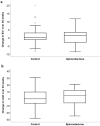The effect of spironolactone on diastolic function in haemodialysis patients
- PMID: 33544240
- PMCID: PMC8255262
- DOI: 10.1007/s10554-021-02176-5
The effect of spironolactone on diastolic function in haemodialysis patients
Abstract
Heart failure with preserved ejection fraction (HFpEF) is highly prevalent in patients on maintenance haemodialysis (HD) and lacks effective treatment. We investigated the effect of spironolactone on cardiac structure and function with a specific focus on diastolic function parameters. The MiREnDa trial examined the effect of 50 mg spironolactone once daily versus placebo on left ventricular mass index (LVMi) among 97 HD patients during 40 weeks of treatment. In this echocardiographic substudy, diastolic function was assessed using predefined structural and functional parameters including E/e'. Changes in the frequency of HFpEF were analysed using the comprehensive 'HFA-PEFF score'. Complete echocardiographic assessment was available in 65 individuals (59.5 ± 13.0 years, 21.5% female) with preserved left ventricular ejection fraction (LVEF > 50%). At baseline, mean E/e' was 15.2 ± 7.8 and 37 (56.9%) patients fulfilled the criteria of HFpEF according to the HFA-PEFF score. There was no significant difference in mean change of E/e' between the spironolactone group and the placebo group (+ 0.93 ± 5.39 vs. + 1.52 ± 5.94, p = 0.68) or in mean change of left atrial volume index (LAVi) (1.9 ± 12.3 ml/m2 vs. 1.7 ± 14.1 ml/m2, p = 0.89). Furthermore, spironolactone had no significant effect on mean change in LVMi (+ 0.8 ± 14.2 g/m2 vs. + 2.7 ± 15.9 g/m2; p = 0.72) or NT-proBNP (p = 0.96). Treatment with spironolactone did not alter HFA-PEFF score class compared with placebo (p = 0.63). Treatment with 50 mg of spironolactone for 40 weeks had no significant effect on diastolic function parameters in HD patients.The trial has been registered at clinicaltrials.gov (NCT01691053; first posted Sep. 24, 2012).
Keywords: Diastolic function; E/e’; Echocardiography; HFpEF; Haemodialysis; Spironolactone.
Conflict of interest statement
Tobias Hauser, Vivien Dornberger, Uwe Malzahn, Sören Grebe, Dan Liu, Matthias Nauck, Nele Friedrich, Marcus Dörr, Vera Krane and Fabian Hammer declared no conflicts of interest. Stefan Störk reported grants from the German Ministry for Education and Research, research grants from Bayer and Boehringer and speaker honoraria/consultation fees from Astra Zeneca, Bayer, Boehringer, Novartis, Pfizer, Sanofi, Servier, all outside the submitted work. Christoph Wanner received grant support and honoraria outside of the present trial from Boehringer-Ingelheim, Idorsia and Sanofi-Genzyme and honoraria from AstraZeneca, Bayer, Chiesi, FMC, GILEAD, GSK, Lilly, MSD and Vifor.
Figures




References
-
- Antlanger M, Aschauer S, Kopecky C, Hecking M, Kovarik JJ, Werzowa J, Mascherbauer J, Genser B, Saemann MD, Bonderman D. Heart failure with preserved and reduced ejection fraction in hemodialysis patients: prevalence, disease prediction and prognosis. Kidney Blood Press Res. 2017;42(1):165–176. doi: 10.1159/000473868. - DOI - PubMed
-
- Han JH, Han JS, Kim EJ, Doh FM, Koo HM, Kim CH, Lee MJ, Oh HJ, Park JT, Han SH, Ryu DR, Yoo TH, Kang SW. Diastolic dysfunction is an independent predictor of cardiovascular events in incident dialysis patients with preserved systolic function. PLoS ONE. 2015;10(3):e0118694. doi: 10.1371/journal.pone.0118694. - DOI - PMC - PubMed
-
- Edelmann F, Tomaschitz A, Wachter R, Gelbrich G, Knoke M, Dungen HD, Pilz S, Binder L, Stahrenberg R, Schmidt A, Marz W, Pieske B. Serum aldosterone and its relationship to left ventricular structure and geometry in patients with preserved left ventricular ejection fraction. Eur Heart J. 2012;33(2):203–212. doi: 10.1093/eurheartj/ehr292. - DOI - PubMed
Publication types
MeSH terms
Substances
Associated data
Grants and funding
LinkOut - more resources
Full Text Sources
Other Literature Sources
Medical
Research Materials

